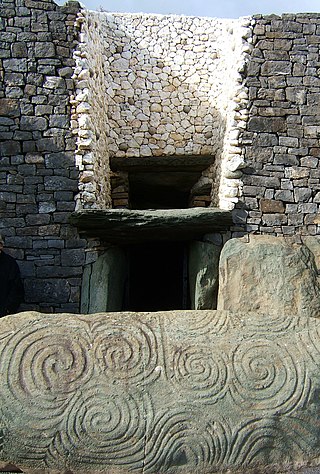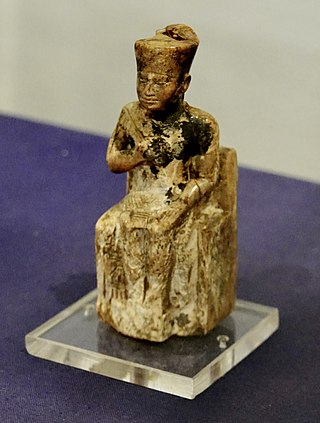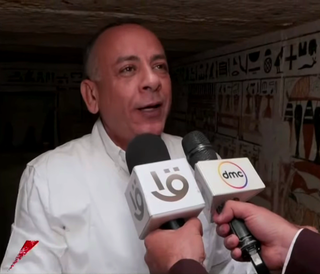
Archaeoastronomy is the interdisciplinary or multidisciplinary study of how people in the past "have understood the phenomena in the sky, how they used these phenomena and what role the sky played in their cultures". Clive Ruggles argues it is misleading to consider archaeoastronomy to be the study of ancient astronomy, as modern astronomy is a scientific discipline, while archaeoastronomy considers symbolically rich cultural interpretations of phenomena in the sky by other cultures. It is often twinned with ethnoastronomy, the anthropological study of skywatching in contemporary societies. Archaeoastronomy is also closely associated with historical astronomy, the use of historical records of heavenly events to answer astronomical problems and the history of astronomy, which uses written records to evaluate past astronomical practice.

The Great Pyramid of Giza is the largest Egyptian pyramid. It served as the tomb of pharaoh Khufu, who ruled during the Fourth Dynasty of the Old Kingdom. Built c. 2600 BC, over a period of about 27 years, the pyramid is the oldest of the Seven Wonders of the Ancient World, and the only wonder that has remained largely intact. It is the most famous monument of the Giza pyramid complex, which is part of the UNESCO World Heritage Site "Memphis and its Necropolis". It is situated at the northeastern end of the line of the three main pyramids at Giza.
In general relativity, a naked singularity is a hypothetical gravitational singularity without an event horizon.

Machu Picchu is a 15th-century Inca citadel located in the Eastern Cordillera of southern Peru on a 2,430-meter (7,970 ft) mountain ridge. Often referred to as the "Lost City of the Incas", it is the most familiar icon of the Inca Empire. It is located in the Machupicchu District within Urubamba Province above the Sacred Valley, which is 80 kilometers (50 mi) northwest of Cusco. The Urubamba River flows past it, cutting through the Cordillera and creating a canyon with a tropical mountain climate. In reference to the site's name, for most English or Spanish speakers, the first 'c' in Picchu is silent. In English, the name is pronounced MAH-choo PEE-choo or MATCH-oo PEAK-choo, in Spanish as or, and in Quechua as.

Saqqara, also spelled Sakkara or Saccara in English, is an Egyptian village in the markaz (county) of Badrashin in the Giza Governorate, that contains ancient burial grounds of Egyptian royalty, serving as the necropolis for the ancient Egyptian capital, Memphis. Saqqara contains numerous pyramids, including the Pyramid of Djoser, sometimes referred to as the Step Tomb, and a number of mastaba tombs. Located some 30 km (19 mi) south of modern-day Cairo, Saqqara covers an area of around 7 by 1.5 km.

Giza is the third-largest city in Egypt by area after Cairo and Alexandria; and fourth-largest city in Africa by population after Kinshasa, Lagos, and Cairo. It is the capital of Giza Governorate with a total population of 4,872,448 in the 2017 census. It is located on the west bank of the Nile opposite central Cairo, and is a part of the Greater Cairo metropolis. Giza lies less than 30 km (18.64 mi) north of Memphis, which was the capital city of the unified Egyptian state during the reign of pharaoh Narmer, roughly 3100 BC.

Khufu or Cheops was an ancient Egyptian monarch who was the second pharaoh of the Fourth Dynasty, in the first half of the Old Kingdom period. Khufu succeeded his father Sneferu as king. He is generally accepted as having commissioned the Great Pyramid of Giza, one of the Seven Wonders of the Ancient World, but many other aspects of his reign are poorly documented.

The Great Sphinx of Giza is a limestone statue of a reclining sphinx, a mythical creature with the head of a human and the body of a lion. Facing directly from west to east, it stands on the Giza Plateau on the west bank of the Nile in Giza, Egypt. The face of the Sphinx appears to represent the pharaoh Khafre. The original shape of the Sphinx was cut from the bedrock, and has since been restored with layers of limestone blocks. It measures 73 m (240 ft) long from paw to tail, 20 m (66 ft) high from the base to the top of the head and 19 m (62 ft) wide at its rear haunches.

The Egyptian pyramids are ancient masonry structures located in Egypt. Sources cite at least 118 identified "Egyptian" pyramids. Approximately 80 pyramids were built within the Kingdom of Kush, now located in the modern country of Sudan. Of those located in modern Egypt, most were built as tombs for the country's pharaohs and their consorts during the Old and Middle Kingdom periods.

The pyramid of Khafre or of Chephren is the middle of the three Ancient Egyptian Pyramids of Giza, the second tallest and second largest of the group. It is the only pyramid out of the three that still has cladding at the top. It is the tomb of the Fourth-Dynasty pharaoh Khafre (Chefren), who ruled c. 2558−2532 BC.

The Giza pyramid complex in Egypt is home to the Great Pyramid, the Pyramid of Khafre, and the Pyramid of Menkaure, along with their associated pyramid complexes and the Great Sphinx. All were built during the Fourth Dynasty of the Old Kingdom of ancient Egypt, between c. 2600 – c. 2500 BC. The site also includes several temples, cemeteries, and the remains of a workers' village.

Mark Lehner is an American archaeologist with more than 30 years of experience excavating in Egypt. He is the director of Ancient Egypt Research Associates (AERA) and has appeared in numerous tv documentaries.

Spanning over three thousand years, ancient Egypt was not one stable civilization but in constant change and upheaval, commonly split into periods by historians. Likewise, ancient Egyptian architecture is not one style, but a set of styles differing over time but with some commonalities.
The Djedi Project was an exploration of the interior of the Great Pyramid of Giza. The project team was made up of international and Egyptian experts. The name derived from Djedi, the ancient Egyptian magician consulted by Pharaoh Khufu when planning his famous pyramid. As Dr. Zahi Hawass announced on his blog: "The purpose of this project is to send a robotic tunnel explorer into the two "air shafts" that lead from the Queen's Chamber of the Great Pyramid of Khufu to gather evidence to determine the purpose of the shafts."

Several ancient Egyptian solar ships and boat pits were found in many ancient Egyptian sites. The most famous is the Khufu ship, which is now preserved in the Grand Egyptian Museum. The full-sized ships or boats were buried near ancient Egyptian pyramids or temples at many sites. The history and function of the ships are not precisely known. They are most commonly created as a "solar barge", a ritual vessel to carry the resurrected king with the sun god Ra across the heavens. This is a common theme in the Pyramid Texts, and these buried boats might be a real-life equivalent of solar barges. Similarly, another explanation behind these boats is that they were built for past kings to carry them to the afterlife. Because of these ships' association with the sun, they are often found in an east-west orientation in order to follow the path of the sun.
The Diary of Merer is the name for papyrus logbooks written over 4,500 years ago by Merer, a middle-ranking official with the title inspector. They are the oldest known papyri with text, dating to the 27th year of the reign of pharaoh Khufu during the 4th dynasty. The text, written with (hieratic) hieroglyphs, mostly consists of lists of the daily activities of Merer and his crew. The best preserved sections document the transportation of white limestone blocks from the Tura quarries to Giza by boat.
Mehdi Tayoubi is Strategy and Innovation Vice-President at Dassault Systèmes, and an employee since 2001. He is the co-director of the ScanPyramids mission launched in 2015 and co-founder of the HIP Institute. In November 2017, he was a co-author with the ScanPyramids team, in the journal Nature, of "Discovery of a big void in Khufu's Pyramid by observation of cosmic-ray muons".The team revealed their third discovery named ScanPyramids Big Void thanks to muography.
The ScanPyramids mission is an Egyptian-International project designed and led by Cairo University and the French HIP Institute. This project aims at scanning Old Kingdom Egyptian Pyramids to detect the presence of unknown internal voids and structures.

Mostafa Waziri was the secretary-general of the Supreme Council of Antiquities of Egypt.













